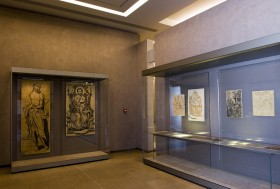IV.2. From anthibolon to icon
“Anthibola” (working sketches), designed to help reproduce iconographic subject matter, are as much part of the tools of his trade for a painter as paints and brushes. They are the working drawings of mainly post-Byzantine painters, initially most widespread in Crete and Venetian-dominated areas. The increasing demand for icons and the spread of paper as a drawing medium gradually led to their becoming commonplace in the wider Greek region, in almost all the important centres of Post-Byzantine art.
They were a precious resource, handed on (sold, bartered or bequeathed) from one painter to another, transferring a particular iconographic tradition (iconographic types and characteristics) from one workshop to another.
The use of the term “anthibolon” or “athibolon” became widely established in the 18th c. thanks to Dionysios of Phourna and his “Hermeneia” (Painters’ Manual), which also provided the basic guide to the technicalities of making and using “anthibola”.
-

The Entombment and Assumption of St John the Evangelist
BXM: 001651
Exhibition room: IV.2 From anthibolon to icon
details -

Entombment and Assumption of Saint John the Theologian
BXM: 013012
Exhibition room: IV.2 From anthibolon to icon
details








